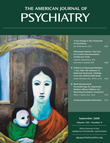Variants in Nicotinic Receptors and Risk for Nicotine Dependence
Abstract
Objective: A recent study provisionally identified numerous genetic variants as risk factors for the transition from smoking to the development of nicotine dependence, including an amino acid change in the α5 nicotinic cholinergic receptor ( CHRNA5 ). The purpose of this study was to replicate these findings in an independent data set and more thoroughly investigate the role of genetic variation in the cluster of physically linked nicotinic receptors, CHRNA5-CHRNA3-CHRNB4 , and the risk of smoking. Method: Individuals from 219 European American families (N=2,284) were genotyped across this gene cluster to test the genetic association with smoking. The frequency of the amino acid variant (rs16969968) was studied in 995 individuals from diverse ethnic populations. In vitro studies were performed to directly test whether the amino acid variant in the CHRNA5 influences receptor function. Results: A genetic variant marking an amino acid change showed association with the smoking phenotype (p=0.007). This variant is within a highly conserved region across nonhuman species, but its frequency varied across human populations (0% in African populations to 37% in European populations). Furthermore, functional studies demonstrated that the risk allele decreased response to a nicotine agonist. A second independent finding was seen at rs578776 (p=0.003), and the functional significance of this association remains unknown. Conclusions: This study confirms that at least two independent variants in this nicotinic receptor gene cluster contribute to the development of habitual smoking in some populations, and it underscores the importance of multiple genetic variants contributing to the development of common diseases in various populations.



